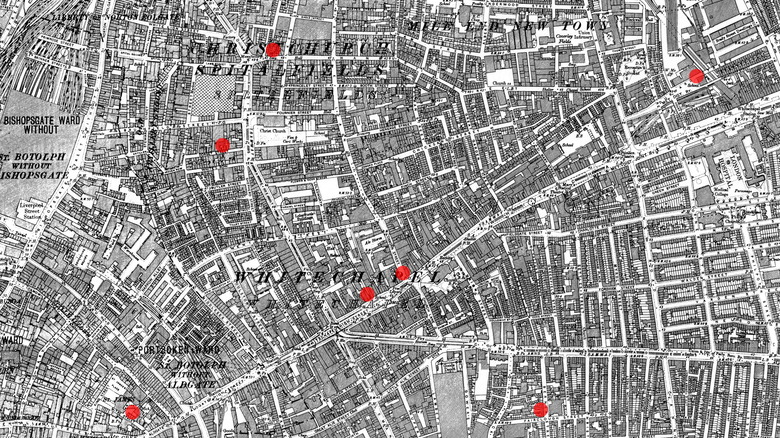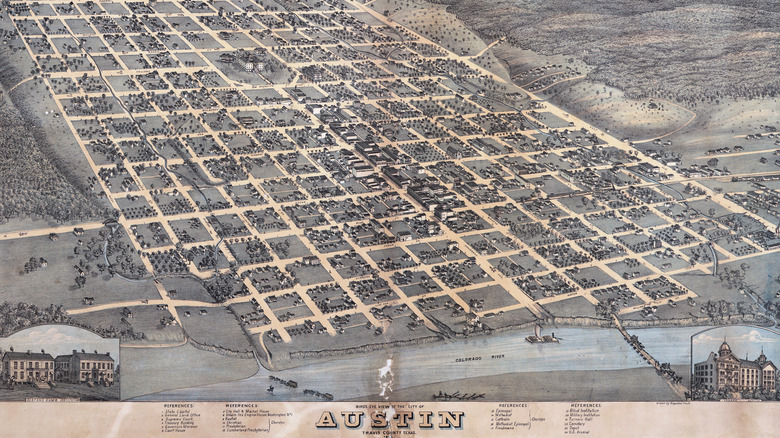One Theory Suggests Jack The Ripper Was Also Texas' Infamous Servant Girl Annihilator
One of the most infamous crime sprees in recorded history took place over the course of a few months in London in 1888. The killer (or killers) gruesomely murdered at least five women. History has given him the nickname Jack the Ripper, as Britannica reports, but that's about the beginning and the end of what can be said conclusively about the identity of the killer. What clues we've managed to find have yielded more questions than answers, and we may never know the identity of the murderer.
A less well-known crime spree of the late 19th century took place in Texas a few years earlier. As PBS reports, in 1884, a killer (or killers) murdered at least eight people around Austin, and the suspect has been given the nickname the "Servant Girl Annihilator," per KVUE. And as it turns out, Jack the Ripper and the Servant Girl Annihilator may be the same person. There are striking similarities between a suspect in the Texas murders and a suspect in the London murders. Further still, the Texas suspect fled town a few years before women started turning up dead in London, so the math adds up.
Jack the Ripper
The section of London known as Whitechapel was, in the late 1880s, known for being the workplace of sex workers. And at least one of them was murdered in 1888, by the same murderer (or murderers) who murdered at least four other women, who also may or may not have been sex workers. As Britannica reports, for a century it's more or less been considered canon that Mary Ann Nichols, Annie Chapman, Elizabeth Stride, Catherine (Kate) Eddowes, and Mary Jane Kelly were all sex workers and possibly soliciting on the streets at the time of their murders. However, later scholarship has suggested that prejudicial Victorian attitudes about women and the poor may have caused historians to falsely conclude that they were sex workers.
All of the women, and possibly other victims, were mutilated in such a way that suggested the killer had knowledge of human anatomy and may even have been a physician. Further still, the murderer taunted authorities, including sending a note in which he identified himself as "Jack the Ripper." He even sent a portion of a kidney to the police.
The Servant Girl Annihilator
Years before the first confirmed victim of Jack the Ripper was discovered in London, a murderer was terrorizing people in Austin, Texas. The first victim was a Black woman named Mollie Smith, according to Texas Monthly, who was found behind her employer's home with a pronounced wound in her head. A few months later, a cook named Eliza Shelley was found dead by her children, with her head split from an ax wound.
All told, eight murders would be tied to the same killer or killers, and none other than writer O. Henry, who at the time lived and worked in Austin (per KVUE), gave him the nickname the "Servant Girl Annihilator." That name isn't actually 100% accurate, however, as one victim was actually a man, and not all of them were servants. And while many of the first victims were Black, the final two were a white teenage girl and a white adult woman.
As quickly as the murders began, they stopped. And as the fledgeling and haphazard police force in Austin tried to put the pieces together, the murderer might have skipped town — and might even have crossed the Atlantic Ocean.
Similarities and differences
There are a number of similarities between the Austin crime spree and the London crime spree, possibly suggesting that there might be a connection. However, there are several differences as well.
In both sets of murders, the assailant preyed upon victims from the lower classes of society. In the Austin case, they were mostly servants — and in a couple of cases, people who were nearby, per Texas Monthly. Meanwhile, in the London case, they were presumed sex workers. And while in both sets of crimes the murderer appeared to be targeting women, the Austin murderer killed at least one man.
The Austin murderer also sexually assaulted and murdered an 11-year-old girl. None of the known London victims were minors, and according to A&E, while history believed for a century that these were sex crimes, later scholarship has suggested that the victims weren't sexually assaulted. And most importantly, Jack the Ripper mutilated his victims after murdering them. However, accounts regarding the victims of the Servant Girl Annihilator — though they confirm that they were murdered brutally — do not mention any post-mortem mutilation. And finally, the Austin murderer evidently did not taunt the police, as the London murderer did.
A suspect in both cases?
Though the Austin and the London murders of the late 1800s took place in different countries an ocean apart, there's a gap of a couple of years between when one crime spree ended and the other began. And in that gap, it's quite possible that the Texas murderer may have skipped town, boarded a ship, and begun plying his trade (so to speak), in another city. And in fact, a man seen around Austin and then seen around London certainly fits the bill.
As CILISOS reports, back in August 1888 — a few days before the first of the murders attributed to Jack the Ripper — a sailor reportedly crossed paths with a Malay cook, possibly using the name "Alaska" (or something phonetically similar) who claimed that he had been robbed by a "woman of bad character," and that if he didn't get justice, he'd murder every woman in Whitechapel and mutilate their bodies. Sure enough, a bit later, the bodies of murdered and mutilated women started turning up in Whitechapel.
What does this have to do with Austin? According to Austonia, a Malay cook, possibly using the name "Maurice," lived in a rooming house near where the majority of the Austin murders were committed. Perhaps he skipped town when he realized the heat was on?
Connecting the dots
Over the century-plus since the Jack the Ripper murders, untold words have been devoted to the subject in print, to say nothing of the pixels produced by the internet community devoted to solving the mystery. Indeed, from time to time, a book will claim to have identified the killer, but officially, however, the crimes remain unsolved, according to Britannica.
These murders, and the Austin murders that preceded them, are likely to never be solved. That's because these crimes were committed over a century ago; all witnesses are in their graves, as is the perpetrator. If any DNA evidence was left, police in neither Austin nor London would have known how to collect and preserve it, and over the course of nearly 140 years, it's almost certainly gone forever.
And though the prospect of a mysterious foreigner possibly tying the two together seems like a potential avenue for exploration, keep in mind that in the London case, his presence is the result of longstanding hearsay. Hearsay is not evidence, and what's more, the alleged witness could have misheard, had his memories polluted by prejudice, or he could have made the whole thing up. The presence of the Malay cook in both Austin and London may be a coincidence, or it may not have happened at all.





